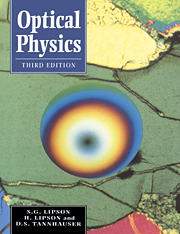Book contents
- Frontmatter
- Contents
- Preface to the third edition
- Preface to the second edition
- Preface to the first edition
- 1 History of ideas
- 2 Waves
- 3 Geometrical optics
- 4 Fourier theory
- 5 Electromagnetic waves
- 6 Polarization and anisotropic media
- 7 Diffraction
- 8 Fraunhofer diffraction and interference
- 9 Interferometry
- 10 Optical waveguides and modulated media
- 11 Coherence
- 12 Image formation
- 13 The classical theory of dispersion
- 14 Quantum optics and lasers
- 15 Problems
- Appendix 1 Bessel functions in wave optics
- Appendix 2 Lecture demonstrations in Fourier optics
- Bibliography
- Index
Preface to the third edition
- Frontmatter
- Contents
- Preface to the third edition
- Preface to the second edition
- Preface to the first edition
- 1 History of ideas
- 2 Waves
- 3 Geometrical optics
- 4 Fourier theory
- 5 Electromagnetic waves
- 6 Polarization and anisotropic media
- 7 Diffraction
- 8 Fraunhofer diffraction and interference
- 9 Interferometry
- 10 Optical waveguides and modulated media
- 11 Coherence
- 12 Image formation
- 13 The classical theory of dispersion
- 14 Quantum optics and lasers
- 15 Problems
- Appendix 1 Bessel functions in wave optics
- Appendix 2 Lecture demonstrations in Fourier optics
- Bibliography
- Index
Summary
We were most encouraged by the publisher's request to revise Optical Physics for a third edition. The request involved considerably more work than we had anticipated; on the one hand we were specifically asked to enlarge our coverage of geometrical optics, fibre optics and quantum optics, and on the other hand not to increase the total length, which obviously necessitated rewriting much of the rest of the book! The requests for the two last topics in particular were very welcome. Both fibre optics and quantum optics have taken great strides forward in the last decade, and a basic understanding of them is essential for any student of physics, not only for a specialist. Since we are not mathematicians, we hope that the approach used for these subjects – an analogy with well-known elementary solved problems in quantum mechanics – will appeal to that section of our readership of a similar ilk. We have certainly learnt a lot in preparing both of these topics. We decided to present geometrical optics in a practical form, which we hope makes it attractive to today's students who have an easy familiarity with computers. We limited ourselves mainly to Gaussian optics, which is of most service to the physicist in general.
We have used the previous editions for more than a decade as the basis for two courses. One is an undergraduate course, which has as prerequisite a knowledge of high-school optics and a familiarity with elementary wave theory and quantum mechanics. This course covers most of Chapters 3, 4, 7, 8, 9, 11 and 12.
Information
- Type
- Chapter
- Information
- Optical Physics , pp. xiii - xivPublisher: Cambridge University PressPrint publication year: 1995
